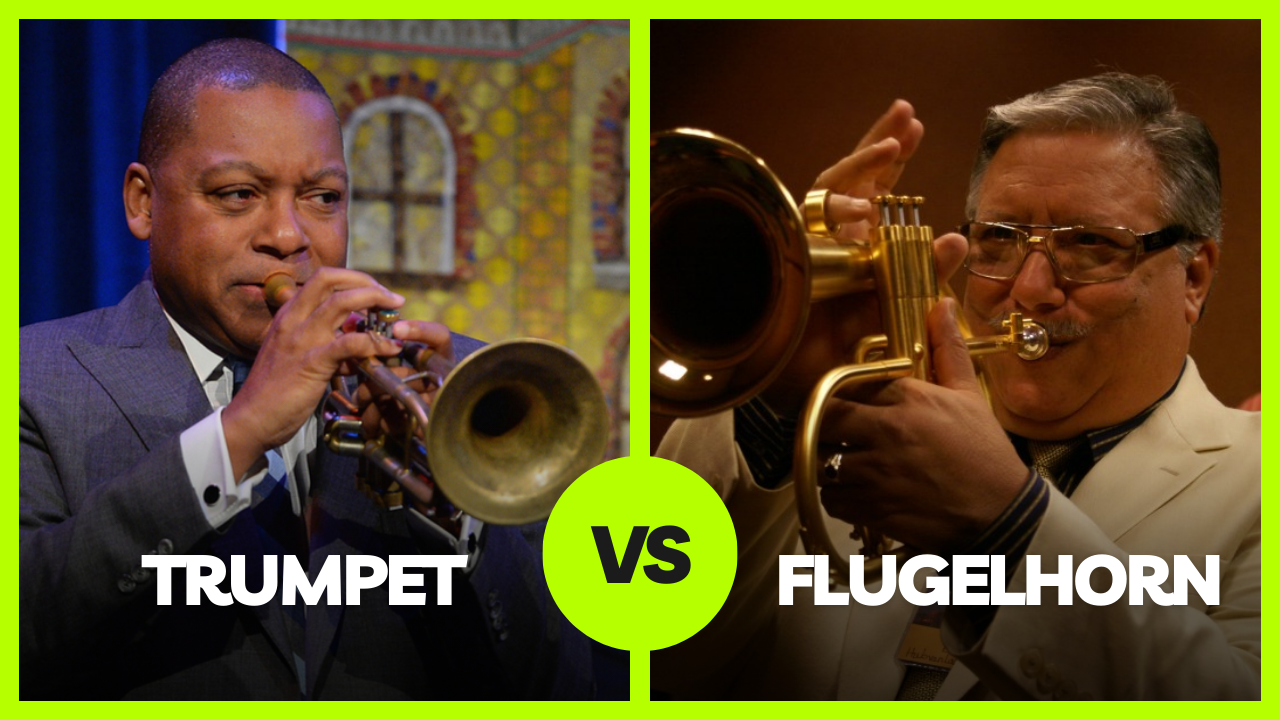Belonging to the brass family of musical instruments, the trumpet and flugelhorn indeed share some similarities since both of them hold a significant place in jazz and classical music. However, they differ in shape, sound, mouthpieces, valves, and keys. In this article, we will explore the differences between the flugelhorn and trumpet in more detail.
Overview of the Trumpet
The trumpet is a small, cylindrical instrument, made of brass, which features a flared bell and three valves. Its group ranges from the piccolo trumpet, known as the instrument with the highest register, to the bass trumpet, with one octave below the standard B♭ or C trumpet. The most common type is the B-flat trumpet, used in many musical genres from classical to contemporary.
The trumpet is one of the most well-known and oldest instruments, with roots going back to ancient times. The first trumpets were crafted from animal horns and were primarily used as early tools of communication due to their loud, piercing sound, especially for signaling about emergencies over long distances, during battles, and for hunting. In Ancient Egypt, Greece, and Rome, trumpets were popular in ceremonial and military settings. They began to be used as musical instruments in the 14th and 15th centuries.
Their construction features a brass tubing bent twice into a rounded shape. The trumpet produces sound by buzzing the musician's lips into the mouthpiece. While musicians couldn’t change the length of tubing of the early trumpets, modern trumpeters have such an opportunity since modern instruments have three (or even four) valves allowing them to change the pitch.
Overview of the Flugelhorn
The flugelhorn is a brass instrument resembling the trumpet and cornet, however having a wider bore compared to them. Flugelhorns are mostly pitched in B♭, though you can also find instruments available in C. The flugelhorn is thought to be a valved bugle, developed in Germany in the early 19th century by Johann Michael Heinrich Stölzel and inspired by the traditional English valveless bugle.
The flugelhorn is present in various musical genres, especially playing a significant role in British-style brass bands which gained popularity in the 19th century. The instrument is also actively used in classical orchestral music, jazz genre, and even as a solo instrument.
The flugelhorn has three piston valves and uses the same fingering system as the trumpet. However, you can also find instruments with four-valves or even rotary-valve versions. Although trumpeters can easily switch to flugelhorns, these instruments differ in playing characteristics.
The Key Differences Between the Trumpet and the Flugelhorn
Now let’s have in-depth analysis to explore how the trumpet differs from the flugelhorn.
Size and Shape
The first things you may notice when looking at these two instruments are their size and shape. Trumpets are longer and narrower than flugelhorns. They have a cylindrical bore and a flared bell, which produce a bright and piercing sound. Flugelhorns, on the other hand, have a conical bore and a wider bell than trumpets, which results in a mellow and warm sound.
Trumpets are 47-54 cm (18.5-21.25 inches) long with a bell diameter of 10-12 cm (4-4.75 inches), while flugelhorns are 35-45 cm (14-28 inches) long with a bell diameter of 15-16 cm (6-6.25 inches).
Sound
The trumpet produces a bright, piercing sound that fits for performing high notes and fast passages. The trumpet is easily heard over other instruments and perfectly cuts through the mix. The sound is produced by the musician's buzzing lips against the mouthpiece, which create the vibration that resonates through the tubing. You can often hear trumpet sounds being described as brassy or metallic.
The trumpet is an essential part of jazz, classical, and marching bands. In addition to the playing technique, the trumpet sound depends on the type of the mouthpiece used by musicians. Smaller mouthpieces result in a brighter sound, while larger models provide a warmer sound.
Similar to the trumpet, the flugelhorn also has three valves, however, the distance between them is larger and wider. It’s played in the same way as the trumpet, but produces a darker and mellower sound. Some people describe it as smoky or velvety. You can definitely hear the flugelhorn when listening to jazz and brass bands, especially in ballads and slow-tempo songs.
Mouthpiece
Trumpets and flugelhorns also differ in sizes and shapes of their mouthpieces. Trumpet mouthpieces feature a V-shaped cup that helps it produce bright sound, while flugelhorn mouthpieces feature a U-shaped cup, resulting in a darker sound. Trumpet mouthpieces are smaller and shallower, while flugelhorn mouthpieces are deeper and wider.
These days, trumpeters can expand their musical possibilities by using adaptors for flugelhorn mouthpieces on the trumpet, helping them fit perfectly into a trumpet receiver by adjusting their shank size and taper. These devices help trumpeters play the trumpet like the flugelhorn, switching between fast-tempo and slower pieces without changing the instrument.
Valves and Keys
The next difference between the trumpet and the flugelhorn is their valves and keys. They both have three valves, while the flugelhorn valves are larger in size and more conical. This peculiarity allows the flugelhorn to provide the musicians with a more open and free-blowing feel. Trumpet valves are smaller resulting in a more focused sound.
Speaking about keys, trumpets have a larger range than flugelhorns. Since their bore is smaller and their mouthpiece is shallower, they are perfect for playing in high register. Flugelhorns, on the other hand, have a wider range of expression thanks to their dark sound.
Conclusion
We hope this guide has helped you explore key differences between trumpets and flugelhorns. Each instrument has its unique shape and sound, as well as holds a special place in classical, jazz, and contemporary music. As a trumpeter you can easily switch to the flugelhorn or use special adaptors for their mouthpieces to expand your repertoire.
On our website you can find many accessories for brass instruments, featuring helpful devices, parts, cleaning tools, and stylish upgrades. Are you searching for more helpful tips? Recently we have shared Top 10 must-have accessories for Trumpet Players in 2025. Check it out to draw inspiration and boost your creativity!







 https://kgumusic.com/pages/about-us
https://kgumusic.com/pages/about-us